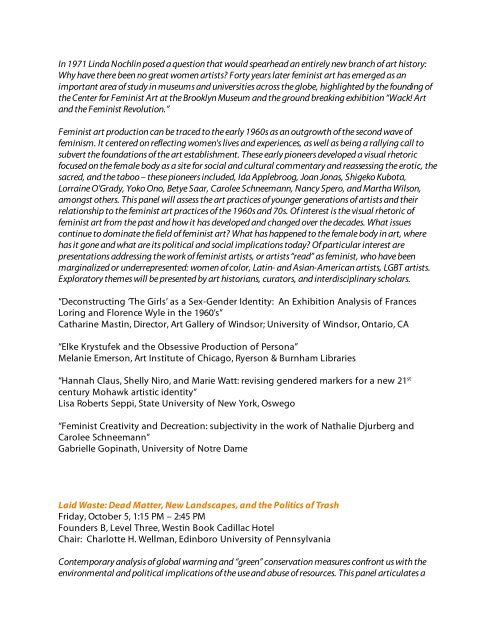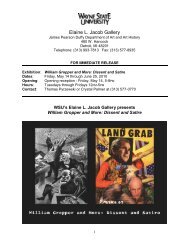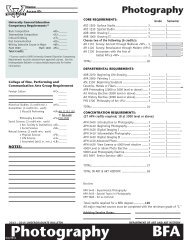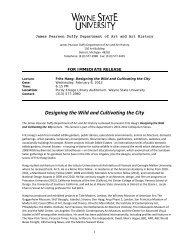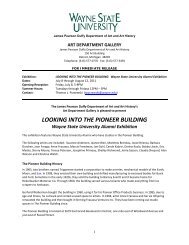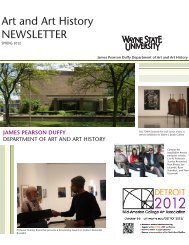linked - Department of Art and Art History - Wayne State University
linked - Department of Art and Art History - Wayne State University
linked - Department of Art and Art History - Wayne State University
You also want an ePaper? Increase the reach of your titles
YUMPU automatically turns print PDFs into web optimized ePapers that Google loves.
In 1971 Linda Nochlin posed a question that would spearhead an entirely new branch <strong>of</strong> art history:<br />
Why have there been no great women artists Forty years later feminist art has emerged as an<br />
important area <strong>of</strong> study in museums <strong>and</strong> universities across the globe, highlighted by the founding <strong>of</strong><br />
the Center for Feminist <strong>Art</strong> at the Brooklyn Museum <strong>and</strong> the ground breaking exhibition “Wack! <strong>Art</strong><br />
<strong>and</strong> the Feminist Revolution.”<br />
Feminist art production can be traced to the early 1960s as an outgrowth <strong>of</strong> the second wave <strong>of</strong><br />
feminism. It centered on reflecting women's lives <strong>and</strong> experiences, as well as being a rallying call to<br />
subvert the foundations <strong>of</strong> the art establishment. These early pioneers developed a visual rhetoric<br />
focused on the female body as a site for social <strong>and</strong> cultural commentary <strong>and</strong> reassessing the erotic, the<br />
sacred, <strong>and</strong> the taboo – these pioneers included, Ida Applebroog, Joan Jonas, Shigeko Kubota,<br />
Lorraine O’Grady, Yoko Ono, Betye Saar, Carolee Schneemann, Nancy Spero, <strong>and</strong> Martha Wilson,<br />
amongst others. This panel will assess the art practices <strong>of</strong> younger generations <strong>of</strong> artists <strong>and</strong> their<br />
relationship to the feminist art practices <strong>of</strong> the 1960s <strong>and</strong> 70s. Of interest is the visual rhetoric <strong>of</strong><br />
feminist art from the past <strong>and</strong> how it has developed <strong>and</strong> changed over the decades. What issues<br />
continue to dominate the field <strong>of</strong> feminist art What has happened to the female body in art, where<br />
has it gone <strong>and</strong> what are its political <strong>and</strong> social implications today Of particular interest are<br />
presentations addressing the work <strong>of</strong> feminist artists, or artists “read” as feminist, who have been<br />
marginalized or underrepresented: women <strong>of</strong> color, Latin- <strong>and</strong> Asian-American artists, LGBT artists.<br />
Exploratory themes will be presented by art historians, curators, <strong>and</strong> interdisciplinary scholars.<br />
“Deconstructing ‘The Girls’ as a Sex-Gender Identity: An Exhibition Analysis <strong>of</strong> Frances<br />
Loring <strong>and</strong> Florence Wyle in the 1960’s”<br />
Catharine Mastin, Director, <strong>Art</strong> Gallery <strong>of</strong> Windsor; <strong>University</strong> <strong>of</strong> Windsor, Ontario, CA<br />
“Elke Krystufek <strong>and</strong> the Obsessive Production <strong>of</strong> Persona”<br />
Melanie Emerson, <strong>Art</strong> Institute <strong>of</strong> Chicago, Ryerson & Burnham Libraries<br />
“Hannah Claus, Shelly Niro, <strong>and</strong> Marie Watt: revising gendered markers for a new 21 st<br />
century Mohawk artistic identity”<br />
Lisa Roberts Seppi, <strong>State</strong> <strong>University</strong> <strong>of</strong> New York, Oswego<br />
“Feminist Creativity <strong>and</strong> Decreation: subjectivity in the work <strong>of</strong> Nathalie Djurberg <strong>and</strong><br />
Carolee Schneemann”<br />
Gabrielle Gopinath, <strong>University</strong> <strong>of</strong> Notre Dame<br />
Laid Waste: Dead Matter, New L<strong>and</strong>scapes, <strong>and</strong> the Politics <strong>of</strong> Trash<br />
Friday, October 5, 1:15 PM – 2:45 PM<br />
Founders B, Level Three, Westin Book Cadillac Hotel<br />
Chair: Charlotte H. Wellman, Edinboro <strong>University</strong> <strong>of</strong> Pennsylvania<br />
Contemporary analysis <strong>of</strong> global warming <strong>and</strong> “green” conservation measures confront us with the<br />
environmental <strong>and</strong> political implications <strong>of</strong> the use <strong>and</strong> abuse <strong>of</strong> resources. This panel articulates a


